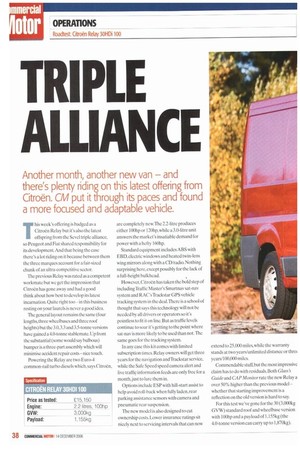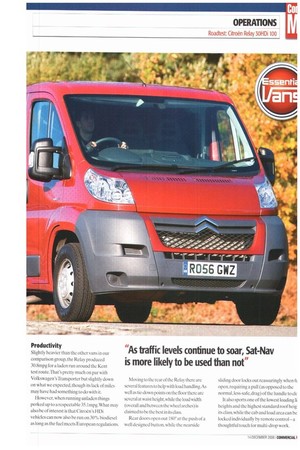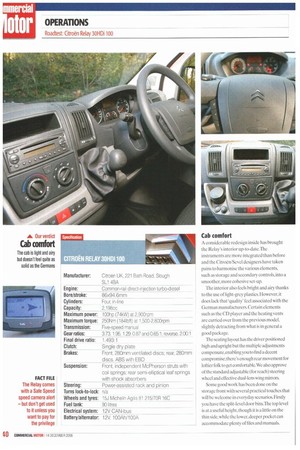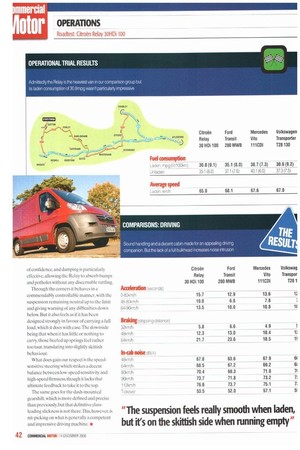TRIPLE ALLIANCE
Page 38

Page 39

Page 40

Page 41

Page 42

Page 43

If you've noticed an error in this article please click here to report it so we can fix it.
Another month, another new van — and there's plenty riding on this latest offering from Citroen. CM put it through its paces and found a more focused and adaptable vehicle.
This week's offering is badged as a Citroen Relay but it's also the latest offspring from the Sevel triple alliance, so Peugeot and Fiat shared responsibility for its development. And that being the case there's a lot riding on it because between them the three marques account for a fair-sized chunk of an ultra-competitive sector.
The previous Relay was rated as a competent workmate but we get the impression that Citroen has gone away and had a good think about how best to develop its latest incarnation. Quite right too in this business resting on your laurels is never a good idea.
The general layout remains the same (four lengt hs, three wheelbases and three roof heights) but the 3.0,3.3 and 3.5-tonne versions have gained a 4.0-tonne stablemate. lip front the substantial (some would say bulbous) bumper is a three-part assembly which will minimise accident repair costsnice touch.
Powering the Relay are two Euro-4 common-rail turbo diesels which, says Citroen, are completely new. The 2.2-litre produces either 100hp or 120hp,while a 3.0-litre unit answers the market's insatiable demand for power with a hefty 160hp.
Standard equipment includes ABS with EBD, electric windows and heated twin-lens wing mirrors along with a CD/radio. Nothing surprising here,except possibly for the lack of a full-height bulkhead.
However,Citroen has taken the bold step of includingTraffic Master's Smartnav sat-nay system and RACsTrackstar GPS vehicle tracking system in the deal.Tbere is a school of thought that says this technology will not be needed by all drivers or operators so it's pointless to fit it on line. But as traffic levels continue to soar it's getting to the point where sat-nay is more likely to he used than not.Tbe same goes for the tracking system.
In any case this kit comes with limited subscription times. Relay owners will get three years for the navigation andTrackstar service, while the Safe Speed speed camera alert and live traffic information feeds are only free for a month,just to lure them in.
Options include ESP with hill-start assist to help avoid roll-back when fully laden, rear parking assistance sensors with camera and pneumatic rear suspension.
The new model is also designed to cut ownership costs. Lower insurance ratings sit nicely next to servicing intervals that can now extend to 25.000 miles,while the warranty stands at two years/unlimited distance or thret years/100,000 miles.
Commendable stuff,but the most impressive claim has to do with residuals. Both Glass's Guide and CAP Monitor rate the new Relay a over 50% higher than the previous model whether that starting improvement is a reflection on the old version is hard to say.
For this test we've gone for the 30 (3,(XX)kg GVW) standard roof and wheelbase version with 100hp and a payload of 1,155kg (the 4.0-tonne version can carry up to 1,870kg).
Productivity
Slightly, heavier than the other vans in our comparison group, the Relay produced 30.8mpg for a laden run around the Kent test route.That's pretty much on par with Volkswagen's Transporter but slightly down on what we expected, though its lack of miles may have had something to do with it.
However,when running unladen things perked up to a respectable 35.1inpg.What may also be of interest is that Citroen's HDi vehicles can now also be run on 30% biodiesel as long as the fuel meets European regulations.
Moving to the rear ol the Relay there arc several features to help with load handling.As well as tie-down points on the floor there are several at waist height,while the load width (overall and between the wheel arches) is claimed to be the best in its class
Rear doors open out 180' at the push of a well designed button. while the nearside sliding door locks out reassuringly when ft open, requiring a pull (as opposed to the nornial, less-safe, drag) of the handle to cic It also sports one of the lowest loading Ii heights and the highest standard roof heig its class, while the cab and load area can be locked individually by remote control — a thoughtful touch for multi-drop work.
Cab comfort
A considerable redesign inside has brought the Relay's interior up-to-date.The instruments are more integrated than before and the Citroen/Sevel designers have taken pains to harmonise the various elements, such as storage and secondary controls,into a smoother, more cohesive set-up.
The interior also feels bright and airy thanks to the use of light-grey plastics. Hovvever, it does lack that 'quality' feel associated with the German manufacturers. Certain elements such as the CD player and the heating vents are carried over from the previous model. slightly detracting from what is in general a good package.
Theseating layout has the driver positioned high and upright but the multiple adjustments compensate.enabling you to find a decent compromise:there's enough rear movement for loftier folk to get corn fortable.We also approve of the standard adjustable (for reach) steering wheel and effective dual-lenswing mirrors.
Some good work has been done on the storage front with several practical touches that will be welcome in everyday scenarios. Firstly you have the split-level door bins.The top level is at a useful height, though it is a little on the thin side,while the lower,deeper pocket can accommodate plenty of files and manuals. Then there's a fold-up A4 clipboard located above the central console, as well as a folddown clipboard and drinks holder into the central seat back. And that's not all.There are two gloveboxes (both lockable) and two passenger parcel shelves with an overhead shelf. You get the picture.
Improvements have been made to cabin insulation to help reduce noise intrusion, but this good intention,while evident at lower speeds, is ruined by the lack of full bulkhead. Road roar swells up from the rear and infiltrates as you reach 40mph,and it dominates the environment once on the motorway.
On the road
At first glance the Relay's exterior design doesn't quite gel into a coherent whole.The many straight lines and protruding bumper up front contrast sharply with the plain side panels (a bit more detail here would have helped the cause). But spend a week with and the individual look does grow on you especially finished in sophisticated pearlc Deep Red. as seen here.
There has also been some tinkering down below, with a re-engineered chassis and suspension. It feels more together tIn the old model and it's more assured on till move. Steering is precise, giving a feeling of confidence, and damping is particularly effective. allowing the Relay to absorb bumps and potholes without any discernable rattling.
Through the corners it behaves in a commendably controllable manner, with the suspension remaining neutral up to the limit and giving warning of any difficulties down below. Rut it also feels as if it has been designed strongly in favour of carrying a full load, which it does with ease.The downside being that when it has little or nothing to carry, those beefed up springs feel rather too taut, translating into slightly skittish behaviour.
What does gain our respect is the speedsensitive steering which strikes a decent balance between low-speed sensitivity and high-speed firmness, though it lacks that ultimate feedback to take it to the top.
The same goes for the dash-mounted gearshift, which is more defined and precise than previously, but that definitive classleading slickness is not there.This, however, is nit-picking on what is generally a competent and impressive driving machine. • We spent a considerable emu of time with this one (after all, il counts as three vehicles wher you factor in Fiat and Peugeot and it has to be said the bold exterior reflects the steps that have been taken elsewhere in taking this van forward.
It feels more robust and M adaptable to the modern van driver's needs with a practical and attractive cab, increased security features and improve torque characteristics.
It also hits the mark from an operator point of view with low ownership costs and a good load-carrying ability.
However, a bulkhead shouk be included as standard, especially as you get sat-nay i the price. And the suspension doesn't feel too happy when running unloaded.
Overall, however, the revamped Relay is an impressive vehicle that compares well with anything on the market.
CITROEN RELAY 30HD1100
Manufacturer: Citroen UK, 221 Bath Road, Slough SL1 4BA Engine: Bore/stroke: Cylinders: Capacity: Maximum power: Maximum torque: Transmission: Gear ratios: Common-rail direct-injection turbo-diesel 86x94.6mm Four, in-line 2,198cc 100hp (74kW) at 2,900rpm 250Nm (184Ibft) at 1,500-2,800rpm Five-speed manual Final drive ratio: Clutch: Brakes: Suspension: Steering: Turns lock-to-lock: Wheels and tyres: Fuel tank: Electrical system: Battery/alternator: 3.73, 1.95. 1.29. 0.87 and 0.65:1: reverse, 2.00:1 1.493:1 Single dry plate Front, 280mm ventilated discs; rear, 280mm discs. ABS with EBD Front, independent McPherson struts with coil springs; rear semi-elliptical leaf springs with shock absorbers Power-assisted rack and pinion n/a 15,.1 Michelin Agilis 81 215/70R 16C 90 litres 12V CAN-bus
12V, 100Ah/ 1 00A
















































































































































































